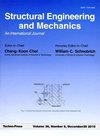Seismic fracture analysis of concrete arch dams incorporating the loading rate dependent size effect of concrete
IF 3
4区 工程技术
Q2 ENGINEERING, CIVIL
引用次数: 2
Abstract
The purpose of this study is to investigate the size effect, loading rate, and smeared crack models in the nonlinear seismic behavior of concrete arch dams. One of the important parameters in the design of arch concrete dams is the tensile strength of unreinforced mass concrete. Various fracture parameters obtained from experimental results reported for concrete in order to study the size-effect is used in this paper. In the present analysis, the smeared crack method is used in finite element analysis of the Morrow Point arch dam subjected to three components of the TAFT earthquake as a case study. The dependence of fracture, and especially of the size effect, on the loading rate is described. Models incorporating nonlinear analysis in three cases with and without the size effect of dam concrete and fluid-structure interaction are employed to evaluate and compare them. The water is taken as an inviscid, compressible fluid, and the foundation is rigid. From the study, it is concluded that the participation of the size effect leads to higher values of maximum displacements and stresses in benchmark points compared to the model that ignores the size effect. The crack initiation criterion based on the maximum tensile stress according to the size effect of concrete, and also the dynamic loading range should be defined. Results show considering fixed smeared crack models used in the concrete specimen as well as the size effect of concrete materials, will lead to the crack profile is more realistic and will represent near to real behavior of concrete fracture. The results are of significant interest for the concrete fracture of dams; hence the loading rate should be adopted for fracture properties obtained in dams.考虑混凝土尺寸效应的混凝土拱坝地震断裂分析
本研究的目的是探讨混凝土拱坝非线性地震行为中的尺寸效应、加载率和涂抹裂缝模型。无筋大体积混凝土的抗拉强度是拱坝设计的重要参数之一。为了研究混凝土的尺寸效应,本文采用了从已有的试验结果中得到的各种断裂参数。本文以TAFT地震三分量作用下的莫罗点拱坝为例,采用涂抹裂缝法进行有限元分析。描述了断裂,特别是尺寸效应对加载速率的依赖关系。采用具有和不具有坝混凝土尺寸效应和流固耦合作用的三种情况下的非线性分析模型对它们进行评价和比较。水被认为是一种无粘性、可压缩的流体,地基是刚性的。研究表明,与不考虑尺寸效应的模型相比,尺寸效应的参与导致基准点的最大位移和应力值更高。应根据混凝土的尺寸效应确定以最大拉应力为起裂准则,并确定动加载范围。结果表明,考虑混凝土试件中使用的固定涂抹裂缝模型以及混凝土材料的尺寸效应,可以使裂缝剖面更加真实,更接近于混凝土断裂的真实行为。研究结果对大坝混凝土断裂具有重要意义;因此,大坝的断裂特性应采用加载率。
本文章由计算机程序翻译,如有差异,请以英文原文为准。
求助全文
约1分钟内获得全文
求助全文
来源期刊

Structural Engineering and Mechanics
工程技术-工程:机械
CiteScore
3.80
自引率
18.20%
发文量
0
审稿时长
11 months
期刊介绍:
The STRUCTURAL ENGINEERING AND MECHANICS, An International Journal, aims at: providing a major publication channel for structural engineering, wider distribution at more affordable subscription rates; faster reviewing and publication for manuscripts submitted; and a broad scope for wider participation.
The main subject of the Journal is structural engineering concerned with aspects of mechanics. Areas covered by the Journal include:
- Structural Mechanics
- Design of Civil, Building and Mechanical Structures
- Structural Optimization and Controls
- Structural Safety and Reliability
- New Structural Materials and Applications
- Effects of Wind, Earthquake and Wave Loadings on Structures
- Fluid-Structure and Soil-Structure Interactions
- AI Application and Expert Systems in Structural Engineering. Submission of papers from practicing engineers is particularly encouraged.
 求助内容:
求助内容: 应助结果提醒方式:
应助结果提醒方式:


